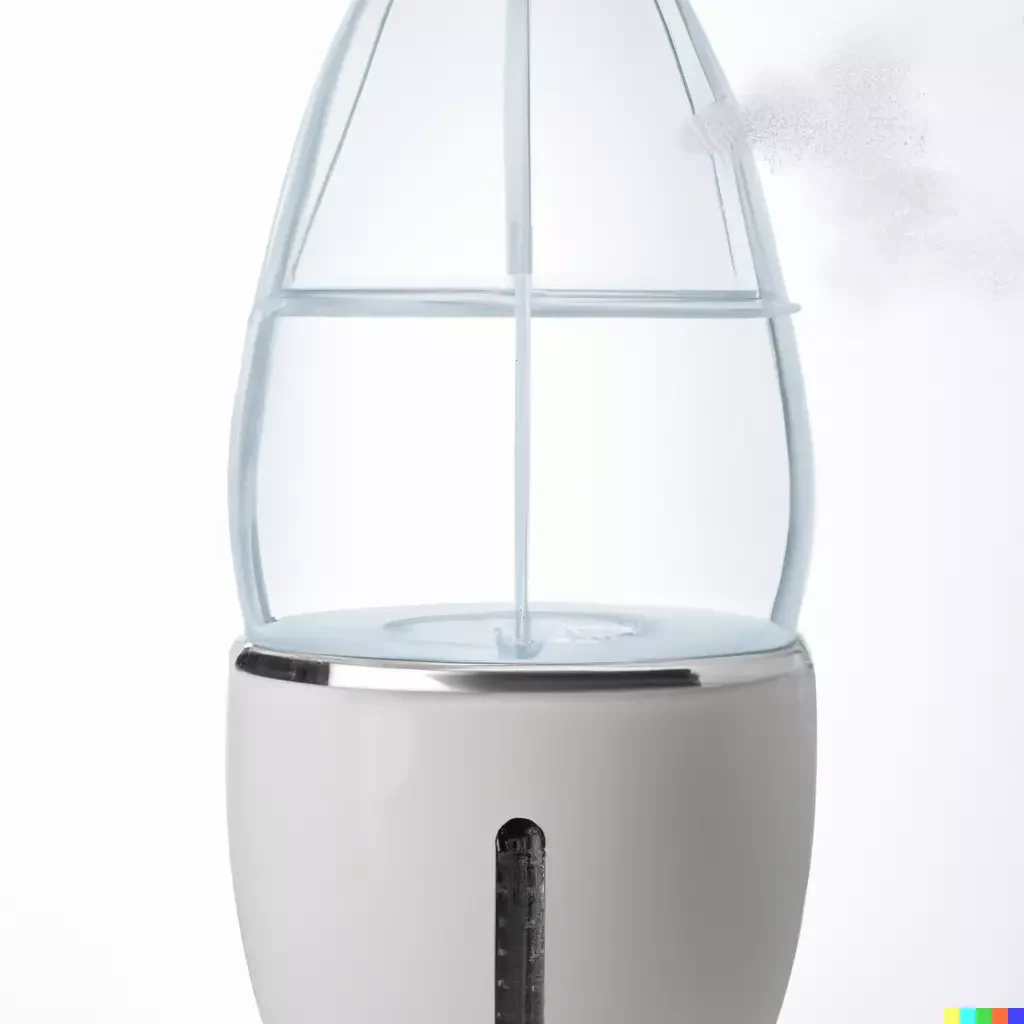For winter, set your humidifier between 30% and 50% humidity. This range helps alleviate dry air effects while preventing condensation.
Dry indoor air during the cold months can wreak havoc on your skin and respiratory system. A humidifier is your go-to device for adding necessary moisture to your home’s atmosphere, creating a more comfortable and health-friendly environment. Maintaining optimal humidity levels is crucial, not just for personal comfort but also for protecting wooden furniture and preventing static electricity.
Yet, balance is key; too much humidity can lead to mold growth and other moisture-related issues. This is where knowing the right setting for your humidifier becomes essential. With the winter season bringing in cooler temperatures, a properly set humidifier can make your indoor space a cozy refuge from the chapping winds and harsh cold outside. Remember to monitor your indoor humidity with a hygrometer to ensure it stays within the recommended range for a comfortable winter season.
The Role Of Humidity In Winter Comfort
The Role of Humidity in Winter Comfort becomes evident as temperatures outside drop. Cold air holds less moisture, making indoor air dry. Dry air can make our homes feel cooler than they actually are because moisture helps hold heat. A good humidifier setting can help maintain a comfortable balance.
Balancing Heat And Moisture
Striking the right balance between heat and moisture is critical. Too little humidity can make your home feel colder. Conversely, too much moisture can lead to condensation on windows and walls. Ideal indoor humidity levels in winter should range between 30-50%. A humidifier with a hygrometer can help maintain these levels.
- Keep humidity at 30-40% in colder climates
- Aim for 40-50% where winter is less severe
- Use a hygrometer to monitor levels
Health Benefits Of Proper Humidity Levels
Appropriate humidity levels are vital for health. Dry air can lead to dry skin, irritated eyes, and respiratory issues. Adequate humidity helps:
- Prevent dry skin and itchiness
- Reduce respiratory problems by keeping airways moist
- Lower the chance of flu and colds
A humidifier with adjustable settings is ideal for keeping your home comfortable and your family healthy in the winter months.
Understanding Your Humidifier
Understanding Your Humidifier is essential as winter approaches. A home humidifier can make frosty days more comfortable. The device combats dry air, keeping your skin, throat, and nasal passages hydrated. It also preserves the health of your wooden furniture. But selecting the right humidifier setting for the cold season is crucial for optimum comfort and energy efficiency. Let’s explore the types available and how they function to ensure your winter is cozy and moisture-balanced.
Types Of Humidifiers For Winter Use
Different humidifiers suit varying needs and preferences:
- Ultrasonic Humidifiers: These use high-frequency vibrations to generate mist.
- Evaporative Humidifiers: Air blows through a wet wick filter to release moisture.
- Steam Vaporizers: They heat water and cool it before expelling it as steam.
Select a model that corresponds with your room size and personal needs.
How Humidifiers Work
A humidifier adds moisture to the air, but each type operates differently. An ultrasonic humidifier creates mist via ultrasonic sound vibrations. The evaporative type uses a fan to evaporate water into the air. Lastly, steam vaporizers heat water to create steam, which cools inside the unit before it’s released. Knowing your unit’s operation can aid in effective maintenance and lead to improved air quality.
Setting The Stage For Winter Humidification
Imagine cozying up in a warm blanket on a cold winter day. Now, imagine that feeling without dry skin, static electricity, or a scratchy throat. That’s the magic of properly humidified air. As we turn up our heaters to combat the cold, the indoor air tends to get drier. This calls for a strategy to keep the humidity levels optimal in our homes, creating a comfortable and healthy environment. Let’s set the stage for effective winter humidification.
Ideal Humidity Levels For Cold Weather
When the temperature drops, a climate-controlled oasis indoors becomes crucial. The ideal indoor humidity level during winter should be between 30% and 50%. This balance prevents problems caused by dry air, such as irritated sinuses and damaged wooden furniture, while also deterring issues from excess moisture, like mold growth.
Assessing Your Indoor Humidity
To maintain that perfect humidity, first assess the current levels. Use a hygrometer, an instrument that measures humidity, for accurate readings. Many digital thermometers come with built-in hygrometers, making it simple to keep an eye on your indoor climate. Once you know your baseline, you can adjust your humidifier settings accordingly.
Remember to check different rooms, as humidity can vary throughout your home. If you find disparities, consider room-specific humidifiers for even distribution of moisture.
To ensure consistency, follow these steps:
- Check the humidity level daily.
- Adjust the humidifier settings as needed.
- Re-evaluate when outdoor temperatures change.
Pay attention to natural signs of low humidity, such as static shocks or gaps in wooden floorboards. Conversely, condensation on windows can signal excess moisture. Adjust your humidifier accordingly to maintain that winter comfort.
Operational Tips For Winter Humidifiers
Winter air can get very dry. A humidifier adds moisture to your home. This keeps your skin and airways from drying out. But, how do you make sure your humidifier works well in winter? Here are some operational tips for your winter humidifier.
Adjusting Settings For Maximum Comfort
Getting the right humidity level is key. A setting between 30% and 50% is often ideal. Here’s how to adjust your humidifier for cozy winter days:
- Start low: Begin with a lower setting. Raise it slowly until you reach a comfy level.
- Watch for condensation: If you see moisture on windows, lower the setting. Too much can lead to mold.
- Use a hygrometer: This tool measures humidity. It helps you keep the perfect level.
- Consider outdoor temperature: Lower humidity if it’s very cold outside to avoid window frost.
Maintenance For Winter Efficiency
A clean humidifier is a happy humidifier. A dirty one can spread germs. Here’s how to maintain yours:
- Change water daily: Always use fresh water to stop germs from growing.
- Clean weekly: Regular scrubbing prevents mold and bacteria buildup.
- Check filters: Some models need new filters often. Follow the maker’s guide.
- Descale: Remove mineral deposits with vinegar or a specialized cleaner.
By following these tips, your winter days and nights will be much more pleasant, keeping dry air at bay.
Common Humidifier Mistakes To Avoid In Winter
Winter brings the chill that makes us love our humidifiers. But a few slip-ups can lead to discomfort or even health issues. Let’s ensure our homes stay cozy without the common humidity hiccups.
Over-humidification Issues
Too much moisture can be as bad as too little. Over-humidification invites mold, dust mites, and structural damage. It’s more than a comfort issue; it’s about health and home integrity.
- Watch out for condensation on windows to avoid mold growth.
- Keep humidity between 30% and 50%. This range prevents damage.
Regularly clean the humidifier. A dirty tank spreads bacteria.
Ignoring Humidity Indicators
Hygrometers measure air moisture. Not using them is like driving without a dashboard. You’re in the dark about your home’s humidity.
| Action | Consequence |
|---|---|
| Ignoring hygrometer readings | Unaware of too high or low humidity levels |
| Not adjusting settings | Waste energy and risk health issues |
Using a hygrometer, you keep your environment balanced and comfortable.

Credit: www.famous-smoke.com
Innovations In Humidity Control
As winter approaches, air gets dry. Dry air causes discomfort. Humidifier settings for winter matter. Luckily, tech advances make comfort easy. Wanna stay cozy? Let’s dive into the latest in humidity control.
Smart Humidifiers For Automated Comfort
No need to fiddle with settings. Smart humidifiers adjust for you. They work with apps and even talk to your smart home systems.
- Connect via Wi-Fi or Bluetooth
- Control through smartphones or voice
- Automatic adjustments to maintain ideal humidity levels
- Schedule on/off times
Advancements In Humidity Sensing Technology
Sensors in new humidifiers are sharp. They detect minor changes in moisture. That means better control over your home’s air quality.
| Feature | Benefit |
|---|---|
| High Precision | Exact humidity readings |
| Fast Response | Quick adjustments to changes |
Comfort Beyond The Humidifier
Setting your humidifier correctly during winter is just one piece of the comfort puzzle. The crisp, cold months call for a warm, cozy home. To achieve that perfect winter warmth, it’s essential to explore comfort beyond just humidifying the air.
Complementary Winter Comfort Strategies
While a humidifier works wonders for comfort, relying solely on it isn’t enough. Let’s explore additional strategies that complement your humidifier:
- Layer Up: Dress in warm layers to retain body heat.
- Warm Beverages: Sip on hot drinks to feel instantly warmer.
- Space Heaters: Use them in commonly used rooms to add warmth.
- Exercise: Stay active to boost circulation and body heat.
Sealing And Insulation For Humidity Retention
Proper sealing and insulation are key to retaining the benefits of your humidifier. They prevent warm, moist air from escaping, leading to better humidity levels and energy savings. Here are some tips:
- Check Windows: Apply weather-stripping to seal drafts.
- Insulate Doors: Use draft stoppers to prevent heat loss.
- Upgrade Insulation: Consider adding insulation to attics and basements.
| Area | Method | Benefits |
|---|---|---|
| Windows | Weather-stripping | Less drafts, better humidity control |
| Doors | Draft stoppers | Reduced heat loss, lower energy bills |
| Attics/Basements | Insulation | Improved temperature regulation, comfort |
Implement these humidity retention strategies to enjoy a warm and inviting home all winter long. Remember, your humidifier isn’t the only hero this season!

Credit: www.aireserv.com

Credit: www.everydayhealth.com
Frequently Asked Questions For Humidifier Setting For Winter
What Should My Humidifier Be Set At In Winter?
Set your humidifier to maintain indoor humidity levels between 30% and 50% during winter. This range helps prevent dry air while avoiding condensation on windows.
What Is A Good Indoor Humidity In Winter?
A good indoor humidity level in winter ranges between 30% and 50%. This range helps maintain comfort and health while reducing static electricity and preserving wooden furnishings and musical instruments.
Is 35 Humidity Too Low In Winter?
Yes, 35% humidity is considered low in winter. It can cause discomfort and increase static electricity. Keeping indoor humidity between 40% and 60% is generally recommended for comfort and health.
What Should The Humidifier Be Set At In The Summer Vs Winter?
Set your humidifier to 30-50% in the summer and 30-40% during the winter to maintain comfortable humidity levels while avoiding condensation issues.
Conclusion
Navigating the optimal humidifier setting during winter just got simpler. Keep your environment comfortable and your health in check. Aim for that ideal 30-50% humidity range. Regular adjustments and maintenance are keys. Embrace these tips, and enjoy a cozier, healthier home as the snow falls outside.




